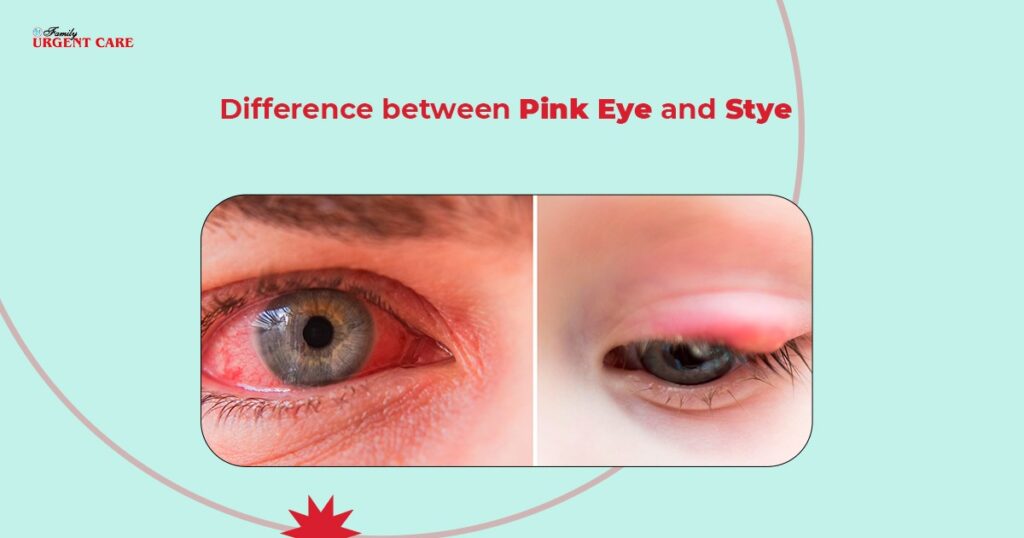There might be times when you wake up in the morning and notice your eyes are crusty, sticky and red. You may feel confused and wonder: Is it pink eye or an eye infection?
In these situations, when you’ve your whole day planned, an eye problem can hinder your daily activities. However, once you know the cause and the exact problem, you can take the right steps to ensure prompt relief.
In this blog, we will explore the differences between pink eye and stye and discuss its causes, symptoms, and treatment options.
What Is The Main Difference Between Pink Eye And Stye?
Pink eye, also known as conjunctivitis, is an inflammation of the conjunctiva, which is the thin clear tissue that lies over the white part of the eye and lines the inside of the eyelid. You may feel itching, irritation and burning in the eyes.
On the contrary, stye is a painful lump on the edge of your eyelid caused by a bacterial infection of an oil gland. You may notice a red, swollen bump that looks like a pimple.
Both of these conditions differ in causes and treatment options. Let’s read further to learn more about the differences.
What Is The Difference In Symptoms Between Pink Eye and Stye?
| Symptoms of Pink Eye | Symptoms of Stye |
| 1. Itching, irritation or burning of the eye 2. Redness in the eyes 3. Watery or teary eyes 4. Eye discharge that may be clear, yellow or white. 5. Blurry vision 6. Swelling of eyelids in the late stage | 1. Soreness and itching 2. Gritty feeling in your eye 3. Red lump on your eyelid 4. Pain around your eye 5. Sensitivity to light 6. Eye pus or sometimes tearing |
Still not sure whether the symptoms are due to pink eye or stye? You can visit a primary care or an urgent care clinic nearby for initial assessment and prompt treatment.
Some Causes of Pink Eye and Styes
One important step in identifying the reason for eye discomfort is to find out the cause. As you already know, pink eye is often caused by bacteria, viruses, or allergies, while stye results from bacterial infection of the oil glands.
| Causes of Pink Eye | Causes of Stye |
| 1. Allergy 2. Viral Infection 3. Irritants or toxic substances 4. Bacterial infection 5. Foreign bodies (dirt or an eyelash) 6. Irritation from contact lenses | 1. Using expired cosmetics 2. Rubbing eyes too often 3. Infection of oil glands in the eyelid 4. Lack of sleep 5. Stress |
What Are The Different Treatment Options For Pink Eye and Stye?
The type of treatment depends on whether you have a viral, bacterial or allergic eye condition.
If you have allergic or viral pink eye, your doctor may advise you to use anti-histamine eye drops to reduce redness and itchiness in the eyes.
However, bacterial pink eye and stye require antibiotic eye drops or ointments for complete healing.
The most common antibiotic eye drops and ointment prescribed by doctors are
- Erythromycin
- Ofloxacin
- Bacitracin
- Ciprofloxacin
You can also use some home remedies to improve your symptoms, such as applying cold compresses to your eyes, washing your eyes with cold water frequently, and wiping your eyes with a clean cloth.
If you have stye, doctors often advise applying warm compresses to the affected eye for 10 minutes almost five times daily. The warm compress would help loosen the clogged oil glands, allowing it to drain.
When to See a Doctor for Pink Eye and Stye?
You should visit a healthcare provider or a doctor if your symptoms don’t improve within 48 hours. Other situations when you need a doctor’s consultation are as follows:
- You experience a clear, yellow, or green discharge from the eyes.
- Your eyelids or eyelashes are sticky and crusty in the morning.
- You notice changes in your vision.
- You have tried over-the-counter medications, but the symptoms are not improving.
If you’re going through any of these symptoms, don’t hesitate to go for an eye examination at a primary care or an urgent care clinic.
Your healthcare provider will review your medical history, evaluate your symptoms, and determine the best treatment plan to improve them right away.
You can even visit our urgent care clinics in Illinois or Indiana if you or your family is experiencing any concerning pink eye or stye symptoms.
How Can I Prevent Having Pink Eye or Stye Again?
Want to protect your eyes from the upcoming season of eye infections? It’s easy peasy! You must take the proper steps and avoid anything that could cause irritation or infections.
Look at these five simple steps that you can take right now to save yourself and your family from pesky eye infections:
- Wash your hands regularly.
- Avoid touching your face and eyes.
- Avoid sharing personal items
- Remove make-up before sleeping
- Don’t reuse disposable contact lenses.
If someone around you has pink eyes, don’t forget to maintain a safe distance and do not share anything.
Can I Visit Urgent Care For Pink Eye Or Stye?
Yes, urgent care providers ensure you receive prompt care and treatment for the irritating symptoms.
If you can’t connect with your primary care provider or are looking for a clinic with extended hours and minimum waiting time, urgent care is the option to consider!
The experienced doctors and healthcare providers will evaluate your symptoms, perform an eye exam and prescribe the right medication to ensure quick relief.
If you experience symptoms like redness, swelling, pain, intense itching, light sensitivity, and yellow or green discharge from the eyes, do not hesitate and walk into the clinic nearby. You can also visit Family Urgent Care if you live in Illinois or Indiana.
How Long Does Pink Eye or Stye Last?
The duration of pink eye and stye depends on the type of infection, the severity of the condition, and the effectiveness of treatment.
Typically, the symptoms of viral pink eye last from 6 to 12 days, whereas bacterial pink eye can last from 4 to 6 days with antibiotic eye drops. Unlike the bacterial pink eye, viral infection can improve without specific treatment.
On the other hand, stye can last from one to two weeks, and it will generally go away on its own. But if it doesn’t, you may need to contact your healthcare provider for proper treatment. They may also prescribe antibiotics to reduce the infection.
How Family Urgent Care Can Help You Get Rid Of Persistent Itching & Grittiness In Eyes?
Once you visit our clinic, our healthcare professionals will perform an eye exam based on your symptoms, diagnose your eye condition and suggest the appropriate treatment.
If you can’t come to our clinic for any reason, there’s no need to worry. Family Urgent Care provides online video and phone consultations, allowing patients to talk to the doctor online.
You can see your healthcare provider without going to their office using your computer, tablet, or smartphone.
So, don’t let eye discomfort disrupt your daily life and book an appointment with us today for the relief you need.

